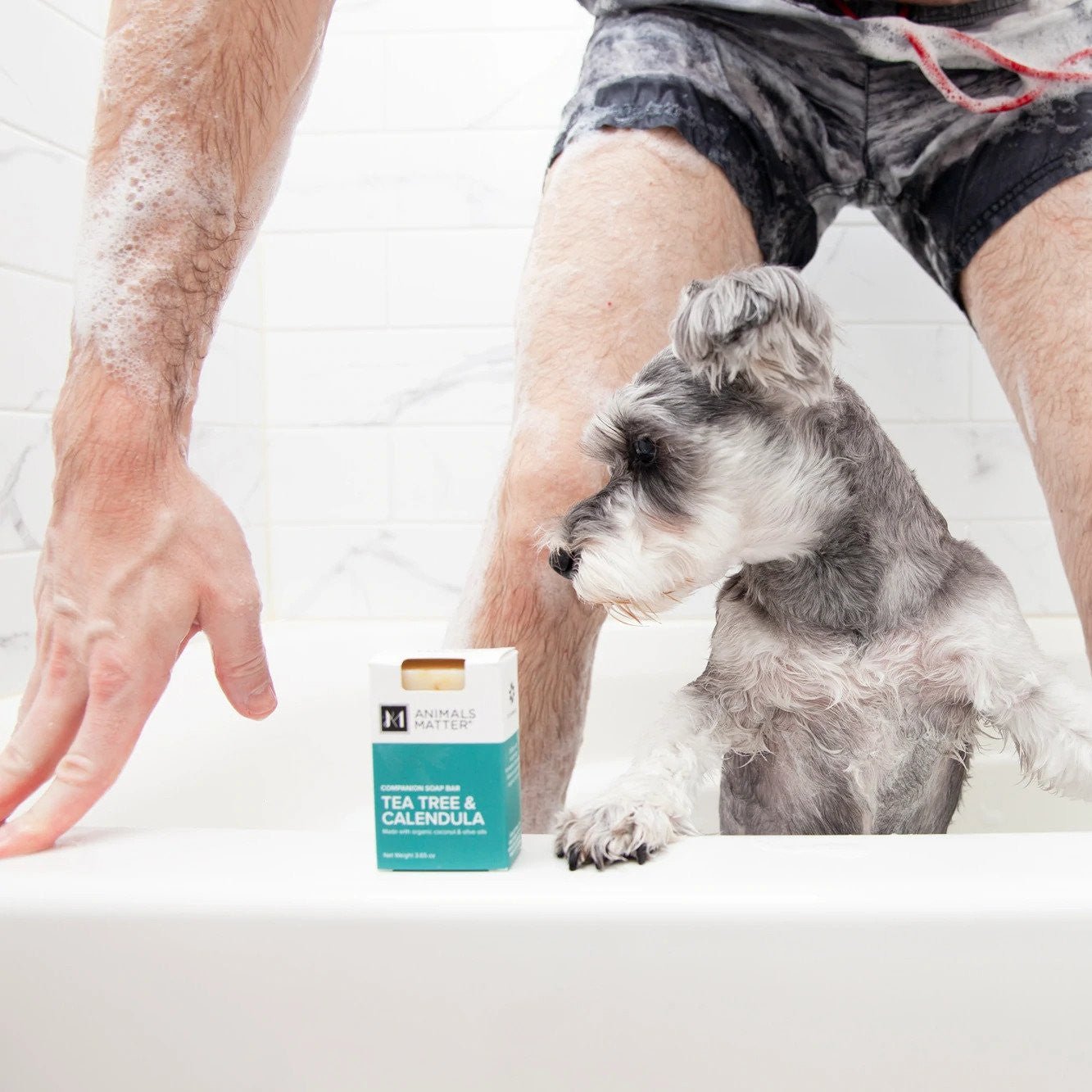The Ultimate Guide to DIY Dog Grooming

When is the right time to hit the groomer for a dog bath? Once a month? Every two months? When your pup decides that cute little black and white kitty is the perfect new playmate and comes home smelling like fresh skunk?
There's no one-size-fits-all answer, as different breeds have different needs. So what's a dog owner to do? Never fear, because we've got some tips that will help give you an idea of when it's time to give your furry friend a much-needed groom.
Grooming Techniques
Before we get into the juicy details about when you should groom, we need to go over a few basics. Grooming includes more than just bathing. You should also consider paw care and nose care. Some techniques need to be done every day, while others can wait.
Grooming can include:
- Brushing
- Hair cuts
- Bathing
- Blowouts
- Shaving
- De-matting
- Expressing anal glands
- Sanitary trims
- Toenail clipping & grinding
Short Fur
It's easy to assume that short fur means less maintenance, and for the most part, that's true. According to The Dog People, your short-furred bestie needs to be brushed on a regular basis. This helps distribute natural oils on their skin, as well as remove debris — which can get caught on dogs as they explore the great unknown. This also helps with shedding. In fact, shedding is common amongst many dog breeds, no matter their fur length. As an example, we own a few rescue “pit” mixes. To say that they shed would be an understatement! They may have short hair. But our floors certainly aren’t short on their hair!
As for bathing, this depends on your dog’s skin. If their skin produces a lot of oil, then you may need to give them a good bath in the tub with a Bar Of Soap for dogs at least once every four to six weeks.
Long Fur
Long fur coats can be beautiful — especially when properly groomed. Most professional groomers recommend that long-coated dogs get groomed every 6 to 8 weeks. As for brushing, this is something that needs to be done at least once a day to prevent shedding and matting. You may still need a furniture protector or Water Proof Blanket to keep all the fur off your couch. But brushing will help prevent some of it. For some breeds, twice a day will help keep their fur long and silky.
Thick Undercoat
Some dogs have a thick undercoat. If this is your pup, then a monthly romp to the tub will do them a lot of good. You may need a special brush. Some brushes like undercoat rakes or slicker brushes will really get in there and get the loose fur out.
Many dogs with thick undercoats get outline trims, which tidy up the fur around the coat. Most groomers highly recommend that you never shave into the undercoat. This can permanently damage your pup’s coat. Plus, a dog’s undercoat prevents sunburns and helps them regulate their body temperature.
Curly Fur
With the rise of “oodle” breeds, many pet owners have curly-furred pups that require special care and attention. Curly-haired or wavy-haired breeds are heavily prone to matting. You should brush them at least once per day to keep their fur thick and gorgeous.
Is your dog currently experiencing matting? Don’t wash them! Instead, try to gently comb out the mats. Using shampoo strips the fur of its natural oils. This often makes the matting “tighter” and more challenging to deal with. You may also be able to detangle mats using a high-quality organic shampoo and conditioner or a de-matting spray.
As for haircuts, try to get them at least once a month. If you maintain the proper grooming and brushing routine, your curly-haired friend can rock that beautiful fur for years to come.
Wiry-Coats
These pups have a lot in common with curly-coated dogs. You'll need to brush wiry coats at least three times a week to prevent matted fur from forming. Bathing should be done every month or two.
Depending on the breed, wiry-coated dogs may or may not need a trim. However, a touch-up around the face, ears, paws, and private areas every four to six weeks helps keep your dog clean and happy.
DIY Grooming vs Professional Grooming
Do you really need to pay someone to groom your pup when you can just do it at home yourself? After all, you just need to scrub them with a good shampoo and conditioner, and you're good to go, right?
While it's entirely up to you what you should do, it's nice to have a few facts before you make up your mind.
DIY Grooming Pros
- No appointment required
- You may save money
- No travel necessary
- Good way to bond with your bestie
- Some anxious dogs may be more comfortable at home
- May be better for dogs with human or animal aggression problems
DIY Grooming Cons
- Cleaning up all that fur can be a pain
- It may not look professionally done
- It can be hard to know how short to trim nails
- Getting the right equipment is expensive
Professional Grooming Pros
- You get a professional looking cut every time
- Groomers are trained to identify things like lumps, rashes, or skin disorders
- You don't have to clean up
- Some will come to your home
- They know how far to trim your pet's nails
- Groomers have professional grooming equipment
Professional Grooming Cons
- Some are expensive
- You (may) have to travel
- Anxious or aggressive dogs may not do well away from home
- You have to trust someone else with your pup
Grooming Your Dog Regularly Helps Keep Them Clean, Happy, and Healthy
Regular grooming is an important part of a dog’s care routine. From curly oodles to short-haired Chihuahuas, every dog has unique needs and grooming requirements. While professional groomers are wonderful and provide value to pet parents across the globe, we firmly believe that anyone can comfortable groom and bathe their pups. All you need is the right shampoo, conditioner, and grooming tools.
Sure! Professional grooming will probably look better. But some pet parents have special pets with special requirements. Your dog may be aggressive towards people or other animals. Or they may just have some anxiety issues. That’s ok! You can give them a great bath and groom at home. As long as you keep up with it, your pup will look wonderful for years to come.
And remember: every animal matters
Subscribe
Sign up to get the latest on sales, new releases and more…
Categories
- Tails of Celebration: Working Dogs of the Lares Trek, A Silent Partnership In Peru
- 5 Easy Organic Christmas Recipes for Dogs: Simple Holiday Treats Your Companion Will Love
- The 6 Best Luxury Gifts for Your Dog This Christmas: Thoughtful Holiday Comfort That Truly Lasts
- Why Playtime Matters: The Benefits of Mental Stimulation and Playtime with Your Companion
- Tails of Celebration: The Miao Dog-Carrying Festival - A Hero's Honor in China
- A Dog-Friendly Thanksgiving 2025: Comfort, Calm, and Easy Treat Recipes
- The Best Dog Beds for Winter 2025: 5 Luxury Styles for Warmth, Comfort & Orthopedic Support
- Tails of Celebration: The Feast of Saint Hubert — Belgium's Timeless Blessing
- Halloween Safety Tips for Dogs: How to Keep Your Companion Safe This Spooky season
- Tails of Celebration: Día de los Muertos / Day of the Dead for Pets, A Festival of Memory in Mexico
- How to Care for Senior Dogs in Fall: Mobility Tips & Joint Support
- Tails of Celebration: Kukur Tihar & The Tihar Festival of Nepal
- What is a VDI Testing for dogs ? : Insights, Procedures and Preventive Measures
- Cheap Dog Beds vs. Luxury Dog Beds: The Real Cost of a $50 "Disposable" Dog Bed
- Can Dogs Have OCD? Understanding Canine Compulsive Behaviors (CCD)
- Does My Dog Like Music? Find Out What Tunes Make Your Pup Wag!
- Effective Solutions for Food Aggression in Dogs
- 7 Frozen Treats Your Dog Will Love This Summer☀️🧊🍉
- The Best Waterproof Liners for Dog Beds: Protect Against Spills, Drool, and Accidents
- How to Cope with the Loss of a Dog: A Tribute to Every Companion We Carry in Our Hearts
- Top Tips on How to Prevent Matting in Dogs
- Understanding and Managing Dogs with Hip Dysplasia
- The Ultimate Guide to Dog Gut Health: Natural Remedies, Probiotic Insights and Signs of Poor Gut Health
- The Best Supplements for Dogs: Explore Top Picks for Canine Health and Wellness
- How Often Should I Brush My Dog's Teeth? Tips for Optimal Canine Dental Health
- Ultimate Guide on How to Comfort Your Dog During Fireworks this 4th of July
- Managing a Blowing Coat: Essential Grooming Tips for Double-Coated Dogs.
- 5 Daily Habits That Boost Your Dog’s Long-Term Wellness
- Mastering Crate Training a Dog: Tips and Benefits
- Dog Car Seats vs. Seat Covers: What’s The Best Option For Your Companion?
- Best Outdoor Dog Beds: Luxury, Durability, and Unmatched Comfort
- Is My Dog Overweight? Tips to Assess and Help Your Companion
- The Best Faux Fur Dog Beds for Ultimate Pet Comfort of 2025
- Dog Running Guide: How to Start, Train & Stay Safe when running with your Dog
- Indestructible Dog Beds? The Truth Behind the Term
- Top Tips for Effective Exercise for Dogs
- Effective Dog Ear Cleaning: A Step-by-Step Guide for Maintaining Healthy Ears
- How to Manage Dog Aggressive Behaviors: Expert Tips and Advice
- Effective Canine Ear Infection Remedies: Symptoms, Causes & Treatments
- How to Make a New Dog Comfortable in Their New Home - 2025 Guide
- Signs of Dog Allergy Symptoms and How to Help and Prevent Them
- Why Does My Dog Lick Their Paws? Causes and Solutions Explained
- Dog Alzheimer's: Symptoms, Causes, and Treatment Options
- The Legacy of Comfort with the Iconic Animals Matter® Ortho Companion-Pedic® Puff Luxury Dog Bed
- Orthopedic Square Dog Beds: The Ultimate Blend of Luxury, Comfort, and Support
- Loungers: The Ultimate Beds for Luxury, Comfort, and Orthopedic Support
- Square Dog Beds: Orthopedic Comfort and Stylish Designs for Your Companion
- Effective Solutions for Canine Incontinence: Identifying Causes and Best Treatments
- Ethical, Sustainable, and Certified: Why Certified Products Matter, Exploring CA Prop 65 and CertiPUR-US® Standards
- Dog Seizures: Signs, Causes, and How to Help Dogs with Seizures


Leave a comment
Please note, comments must be approved before they are published